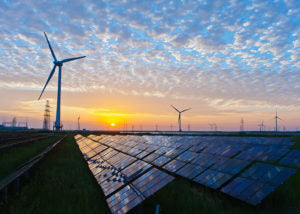As the world hopes to alleviate the growing threat of climate change, India is stepping up to become a global clean energy powerhouse. It is one of the few countries with policies compatible with keeping global warming below the two degrees Celsius target recommended by scientists, according to Climate Action Tracker (CAT), an independent research organization.
 The country also now produces the cheapest solar energy in the world, based on data from the International Renewable Energy Agency or IRENA. And that's not all. Wind energy is also an important resource and, at the end of 2019, installed wind capacity in India exceeded 37 gigawatts.
The country also now produces the cheapest solar energy in the world, based on data from the International Renewable Energy Agency or IRENA. And that's not all. Wind energy is also an important resource and, at the end of 2019, installed wind capacity in India exceeded 37 gigawatts.
In total, the country's renewable energy capacity reached 86 GW last year, with wind power taking up the lion's share.
An early adopter of change
Perhaps the first symbol of India's most significant role in this sphere was the launch of the International Solar Alliance (ISA) at the Paris Climate Conference (COP 21) – thanks to Indian Prime Minister Narendra Modi, in collaboration with Emmanuel Macron, French President .
Started by India, the ISA is an alliance of 121 countries, “aiming to make an unprecedented effort to promote solar energy”. The ISA's goal is to develop standards and deploy solar energy projects in countries rich in solar resources and while climate risks are high.
Long before COP 21, however, India was one of the first nations to create a Ministry of Non-Conventional Energy Sources in 1992 (renamed the Ministry of New and Renewable Energy in 2006), which serves as a testament to the mission of the India to produce clean energy long before global discussions on climate change and sustainability.
Although it was only in 2014 (when the Modi-led National Democratic Alliance took over the government) that renewables really came into play in India. The administration envisioned renewable energy as an affordable and sustainable alternative to polluting fossil fuels. As a result, several policy reforms were created that provided a favorable business environment for private players to enter this field, making it more attractive to serious investors.
At this time, independent power producers (IPP), or non-utility organizations, began to form, with several innovative entrepreneurs venturing into the sector. This has increased the country's competitive interest, potential and support for clean energy sources such as wind and solar. The story of renewable energy in India is a remarkable example of what is possible when government policies and corporate commitment coincide in vision and will.
Being a developing country, India faced several challenges which included meeting the country's growing energy demand based on the size of its population and given its economy. Energy self-sufficiency and universal energy transition were top national priorities. This meant that the country had to overcome its dependence on imports for its energy obligations.
At the same time, as the world's third-largest emitter of greenhouse gases, there has been great pressure on India to reduce its emissions of dangerous pollutants. In 2015, the government announced an aggressive target of 175 gigawatts (GW) of renewables by 2022 – which was later increased to 225 GW. The cumulative impact has been a sharp increase in the country's renewable capacity, with a combined annual growth rate exceeding 20%.
The payoff of clean energy
India currently has around 80 GW of renewable energy space established, up from 35 GW in 2014, with another 30 GW in the pipeline. Solar capacity is now around 30 GW, up from 2.6 GW in 2014. Wind power has also soared to over 36 GW, up from 21 GW in the same period.
An important change in India's renewable energy journey has been the influence of technological advances, which have drastically lowered the unit cost of energy. In addition, new technologies have been developed — such as floating solar power, offshore wind power, wind-solar hybrid projects and battery storage — that should support the development of future projects.
For example, the country currently has plans for the world's largest floating solar plant, at 1 GW, in the state of Madhya Pradesh.
Meanwhile, employment in energy production is a critical area where the renewable energy sector is expected to have a lasting impact. Clean energy will create around 330,000 new jobs by 2022 and more than 24 million different jobs by 2030 in India, according to the International Labor Organization.
The country's goal is to expand the share of renewable energy in the national energy mix to 40% by 2030, which will require 300 GW of new renewable capacity. On the other hand, it will see additional conventional power capacity to 75 GW in the next decade. With the climate crisis looming, renewable energy must be given top priority to mitigate carbon emissions – and so far, so good in India

